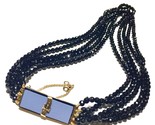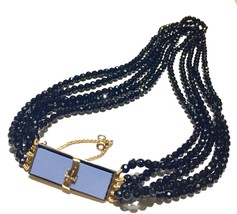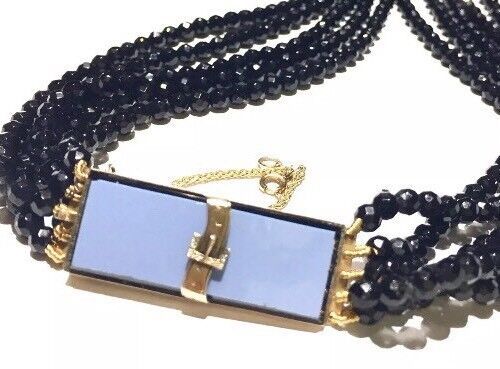Rendered at 09:47:19 05/11/25
Free Shipping
RaRe 15k Victorian French black jet onyx Necklace blue agate buckle clasp
Ships from
United States

Shipping options
No shipping price specified to GB
Ships from
United States

Offer policy
OBO - Seller accepts offers on this item.
Details
Return policy
None: All purchases final
Purchase protection
Payment options
PayPal accepted
PayPal Credit accepted
Venmo accepted
PayPal, MasterCard, Visa, Discover, and American Express accepted
Maestro accepted
Amazon Pay accepted
Nuvei accepted
Shipping options
No shipping price specified to GB
Ships from
United States

Offer policy
OBO - Seller accepts offers on this item.
Details
Return policy
None: All purchases final
Purchase protection
Payment options
PayPal accepted
PayPal Credit accepted
Venmo accepted
PayPal, MasterCard, Visa, Discover, and American Express accepted
Maestro accepted
Amazon Pay accepted
Nuvei accepted
Item traits
| Category: | |
|---|---|
| Quantity Available: |
Only one in stock, order soon |
| Condition: |
Pre-owned |
| Brand: |
Rare |
| Style: |
Beaded |
| Type: |
Necklace |
| Secondary Stone: |
Jet |
| Base Metal: |
Gold |
| Main Stone: |
Onyx |
| Main Stone Color: |
Black |
| Color: |
Black |
| Metal: |
Yellow Gold |
| Country of Origin: |
France |
| Metal Purity: |
14k, 15k |
| Main Stone Treatment: |
Not Enhanced |
| Main Stone Creation: |
Natural |
| Jewelry Department: |
Fine |
| Country/Region of Manufacture: |
France |
| Vintage: |
Yes |
| Theme: |
Angels, Bohemian, Art, Healing, Luck, Gothic |
| Antique: |
Yes |
| Era: |
Edwardian Victorian - authentic item! |
| Original/Reproduction: |
Original |
Listing details
| Shipping discount: |
Seller pays shipping for this item. |
|---|---|
| Posted for sale: |
More than a week ago |
| Item number: |
1484733253 |
Item description
Rare authentic Victorian necklace!
the clasp is big , made in solid 15-16k yellow gold- set with blue agate on top of black onyx). also there is a golden buckle with a ribbon on the top (all patterned on the top!). the clasp has solid gold back base and this layer has a tiny split like curve pattern (it is only on the top and does not go all way through), so I think it was originally made this way when gold was poured by a jeweler in a mold (the mold was not smooth and had some unevenness inside so the gold repeated this and we can see it now as a curve (see last photo please). it is on the opposite side of the clasp, and does not make any influence on its function and not really noticeable but matches curvy edges of the bars which hold the strand and the insertion part of the clasp (see photos of these curvy bars on the opposite side of the clasp). This necklace came from France.
the necklace shows patina and age and light wear (mostly on the clasp; all antique items made of agate always show some wear). But this necklace in very good condition or for a collection! rare authentic item!
smoke free environment and fast free USA priority shipping! fast international delivery if needed!
thank you
a little info about Victorian black jewelry materials:
Black became big in the 1800s both as a fashion statement and as mourning jewelry, a term referencing pieces deemed appropriate to wear during the long period of tribute to a dearly departed relative. Jewelers used many different black substances to create these pieces and often they're hard to distinguish, especially as some were developed deliberately to imitate rare, natural materials.
This feature explores a number of varieties of Victorian black jewelry, with tips on recognizing them
In this slideshow feature, you'll learn about:
Berlin iron
Bog oak
Cut steel
French jet
Gutta Percha
Jet
Onyx
Vulcanite
Like jet, bog oak is wood (actual oak, fir, pine or yew) that has been fossilized in peat marshes or bogs so that it turns hard and black or very dark brown in color. It's also lightweight and warm to the touch, but it usually has a matte finish, as opposed to jet's usual gleaming polish, according to Stockhammer.
Bog oak
Usually from Ireland, bog oak was used for jewelry beginning in the early 1800s, but became more popular in the mid-19th century. This is especially true after 1852, when techniques to mass-mold and decorate it (applying hydraulic or heated pressure to the dried wood) were invented. Although used for mourning jewelry as an economic substitute for jet, it was also worn to support Irish crafts, with pieces often carved or stamped with Gaelic motifs like harps or shamrocks (which would not be considered mourning jewelry). More elegant articles might be studded with pearls or French Jet is black, or extremely dark red, glass rather than a natural substance like true jet. It feels cool, heavy and hard,
French jet
French jet beads are sometimes roughly molded or hand faceted to look like jet, but will be heavier in weight and cold to the touch when compared to the warmth of genuine jet. "If you have a loupe, and detect any chips, they will be curved, striated and almost oval in shape - like a chip in a mirror or glass," Stockhammer noted of French jet.
Developed in the early 19th century and perfected in the 1860s, this type of glass was manufactured in France - hence the name - though also in Austria, England, Germany, and what is now the Czech Republic. Because it was much cheaper to produce than authentic jet, French jet became the premier source of modestly-priced mourning and fashion jewelry.
Gutta Percha
is a rubber-like gum made of the resin derived from trees in Southeast Asia, mainly Malaysia. Like its synthetic cousin, vulcanite, it is brownish-black in appearance (but tended to hold its black matte color over time better), and is molded rather than carved -- so, "sometimes you can detect mold lines, with the eye or a loupe," . It will give off an acrid, rubber smell when rubbed briskly.
Highly flexible yet durable, it was first used in the 1840s for jewelry. In the latter 19th century, it was employed as a less expensive substitute for jet
Natural Jet
Jet, a type of fossilized wood, was perhaps the rarest and most prized black material used to manufacture Victorian jewelry. It is light in weight, and soft and warm to the touch.
Seen under a loupe, it often has tiny, distinctive fissures or chips that differ from French jet (glass). Natural jet can be carved or faceted, but even when precisely cut, it shines rather than sparkles. Keep in mind, however, that jet jewelry meant for first mourning will be matte black rather than shiny, and not all jet jewelry was made for mourning. Victorian fashion jewelry was also made of jet.
Black onyx
is a type of quartz or chalcedony. It "can be confused for French jet," as it too is a bit heavy, cool to the touch and highly polished to a very glossy finish. Jet which can also have a shiny surface, in comparison, is light in weight.
Most black onyx in jewelry is actually dyed black so the color is very even, which can be noted when it is studied with a jeweler's loupe.
Vulcanite
is a type of vulcanized rubber formed by combining sulphur and India rubber, then heating the mixture for several hours. Charles Goodyear is credited with developing the process, which he patented in 1844. Vulcanite can be white or of various colors. As a result, in the mid and late-19th century, the hard substance was often used to imitate coral, tortoiseshell and jet - especially the latter, as dark pieces became more popular, especially with the prevalence of mourning jewelry.
Added to your wish list!

- RaRe 15k Victorian French black jet onyx Necklace blue agate buckle clasp
- 1 in stock
- Price negotiable
Get an item reminder
We'll email you a link to your item now and follow up with a single reminder (if you'd like one). That's it! No spam, no hassle.
Already have an account?
Log in and add this item to your wish list.


























